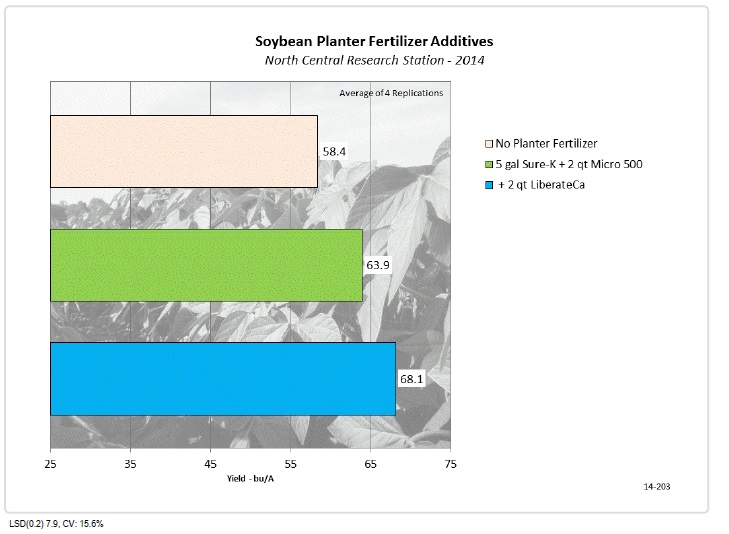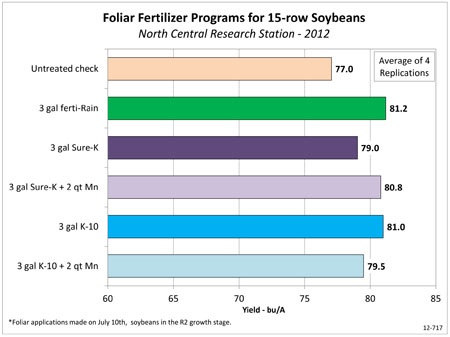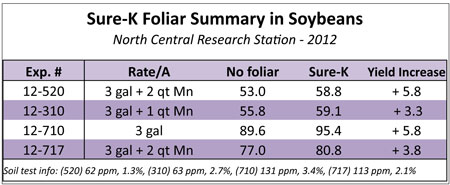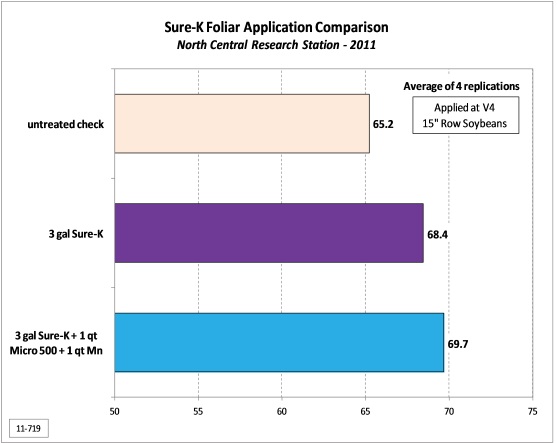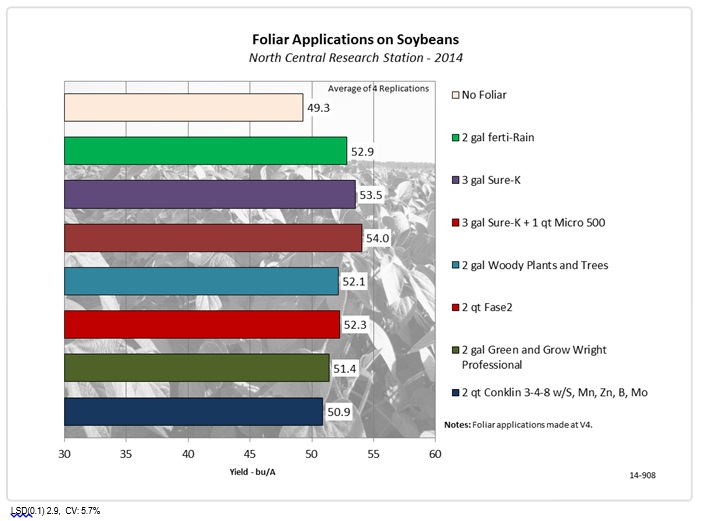Optimizing a soybean fertilizer program can be a challenge. Can soybeans obtain enough fertilizer left over from the previous corn crop? Can planter-applied fertilizers be effective? What about foliar-applied fertilizers? We’ve been researching those questions for more than 30 years! We’ve conducted and compiled research on various soybean crops to help answer these questions and provide some tips on improving your soybean fertilizer program. We’ve updated this post to give you even more information to help you get the most out of your soybean crops.
Tips on Improving Your Soybean Fertilizer Program
Experiment Info
| Planted: | 5/27/2014 |
| Harvest: | 11/2/2014 |
| Yield Goal: | 175 bu/A |
| Target Fert.: | 193-15-73 |
| Variety: | DKC 49-29 RIB |
| Population: | 30,000 |
| Row Width: | 30″ |
| Prev. Crop: | Soybeans |
| Plot Size: | 15 x 820 |
| Replications: | 3 |
| Liquid BC: | 5/27/2014 |
| Sidedress: | 6/30/2014 |
Soil Test Values (ppm)
| pH: | 6.8 |
| CEC: | 11.2 |
| %OM: | 2.3 |
| Bray P1: | 25 |
| Bicarb P: | – |
| K: | 99 |
| S: | 14 |
| %K: | 2.3 |
| %Mg: | 21.9 |
| %Ca: | 75.1 |
| %H: | 0 |
| Zn: | 0.9 |
| Mn: | 4 |
| B: | 0.6 |
Adding Calcium to Soybean Fertilizer Programs
We conducted this test to assess the yield benefit of adding a phosphorus compatible calcium source to a soybean planter fertilizer program. Many soils and crops can benefit from applications of calcium. However compatibility with phosphorus fertilizers is an issue.
LiberateCa is a 2% calcium product that safely mixes with fertilizers containing phosphorus, without worry of incompatibility. An experiment was established at the NCRS that has an average percent base saturation of calcium at 68%. With a pH of 7.7 and good potassium level at 4.5% base saturation, the biggest concern is a slightly elevated magnesium base saturation. To help adjust those levels in a seed zone and provide extra calcium 2 qt/A of LiberateCa was applied in-furrow with a planter program of 5 gal/A Sure-K and 2 qt/A Micro 500. Yield response appears on the chart below.
Conclusions:
- The standard program of 5 gal/A of Sure-K with 2 qt/A Micro 500, based off of soil test, increased soybean yield over the untreated check by 5.5 bu/A.
- The addition of LiberateCa to the AgroLiquid program further increased soybean yield by over 4 bu/A.
Foliar Feeding Soybean Fertilizer Programs
Foliar applications are a top-line management tool for delivering supplemental nutrition when your soybeans need it most. You may wonder if foliar applications are worth the time and investment for your soybean crop. While they can never replace a balanced fertility program, foliar applications continue to be a great option for delivering supplemental nutrition throughout the season.
For soybeans, as with all crops, a good nutrition program must be in place prior to foliar feeding. That’s because healthy, actively-growing plants have a better chance of responding well to foliar applications than stressed ones. Research shows soybeans respond well to foliar applications when the product is a good fit for the situation. For instance, a balanced product like ferti-Rain™ can improve yields on marginal soils. When potassium levels fall short, Sure-K® can make up the difference.
Agronomists assessed 15”-row soybeans for their response to foliar treatments of ferti-Rain™, Sure-K® and an experimental product known as K-10. Soil tests indicated low levels of manganese in the test plot. To address this issue, two treatments combined manganese with the potassium products. All applications took place at the R2 growth stage. The application of 3 gal/A ferti-Rain™ produced the highest yields at 81.2 Bu/A. Treatments of ferti-Rain™, Sure-K® + Mn, and K-10 significantly increased yields over the untreated check.
Sure-K® as a foliar treatment is an excellent way to supply potassium to your soybeans if test levels are low. The addition of Sure-K® to herbicide applications also saves trips across the field.
In this test, agronomists conducted four foliar application trials of Sure-K® on soybeans. Three took place at the R2 early flowering stage; the fourth (Exp. 12-520) at the V4 (4 trifoliate) stage. Yield increases for all four experiments averaged 4.6 Bu/A over the untreated checks.
How Does Sure-K Work for Soybeans?
Wondering how Sure-K can help your soybean fertilizer plan? In this video, Research Field Manager Stephanie Zelinko explains why Sure-K is the most efficient, economical potassium option for soybeans.
Adding Micronutrients to a Foliar Feeding Soybean Fertilizer Program
This experiment evaluates the benefits of adding micronutrients into a soybean fertilizer program using foliar feeding, when soil tests are low for micronutrients. This location has an extremely low soil level on manganese at 2 ppm. In addition to the 3 gal/A Sure-K, 1 qt of Micro 500 and 1 qt of MicroLink Manganese were added to the application. Applications were made to 15” row soybeans that were 9-inches tall in the V4 growth stage.
Conclusions:
- Both foliar programs with and without micronutrients significantly increased soybean yield over the untreated check.
- The addition of 1 qt/A of Micro 500 and 1 qt/A MicroLink Manganese increased soybean yield 1.3 bu/A over the Sure-K only foliar program.
Comparing Foliar Fertilizer Treatments on Soybeans
Evaluation of foliar fertilizer sources applied on 15″-row soybeans in the V4 stage of growth.
For years the NCRS has shown the positive effects that foliar fertilizers can have on soybean yield. This year an experiment was established to compare AgroLiquid fertilizers standard foliar programs if ferti-Rain and Sure-K to other AgroLiquid products not necessarily thought of as soybean foliars. These were Woody Plants and Trees, Fase2 and Green and Grow Wright Professional, These specialized products contain a balance of micronutrients that may prove beneficial in a foliar application. In addition, one outside source was tested for comparison, Conklin’s 3-4-8 with micronutrients was applied at their recommended rate of 2 qt/A. Applications were mixed with water and made at a total spray volume of 10 gal/A in mid-July when the soybeans were in the V4 growth stage. Yield results appear on the chart below.
Conclusions:
- All foliar applications increased soybean yield over the no foliar check.
- Traditionally used soybean foliar products ferti-Rain and Sure-K provided the highest yields in this experiment.
- Highest yield of 54 bu/A was achieved with the addition of 1 qt/A Micro 500 to the Sure-K foliar program.
- The other products not commonly used as a soybean foliar application did not yield as much as the Sure-K or
ferti-Rain.
Can you improve your soybean fertilizer program this year? The best way to decide is to look at the overall picture and contributing factors on your farm. Soil test results, tissue analysis, known soil deficiencies, visual observations and economics should all weigh in on your decision. Our agronomists can help you conduct these tests can help you design a soybean fertilizer program that will help you meet your goals. Talk to an agronomist today to learn more.


